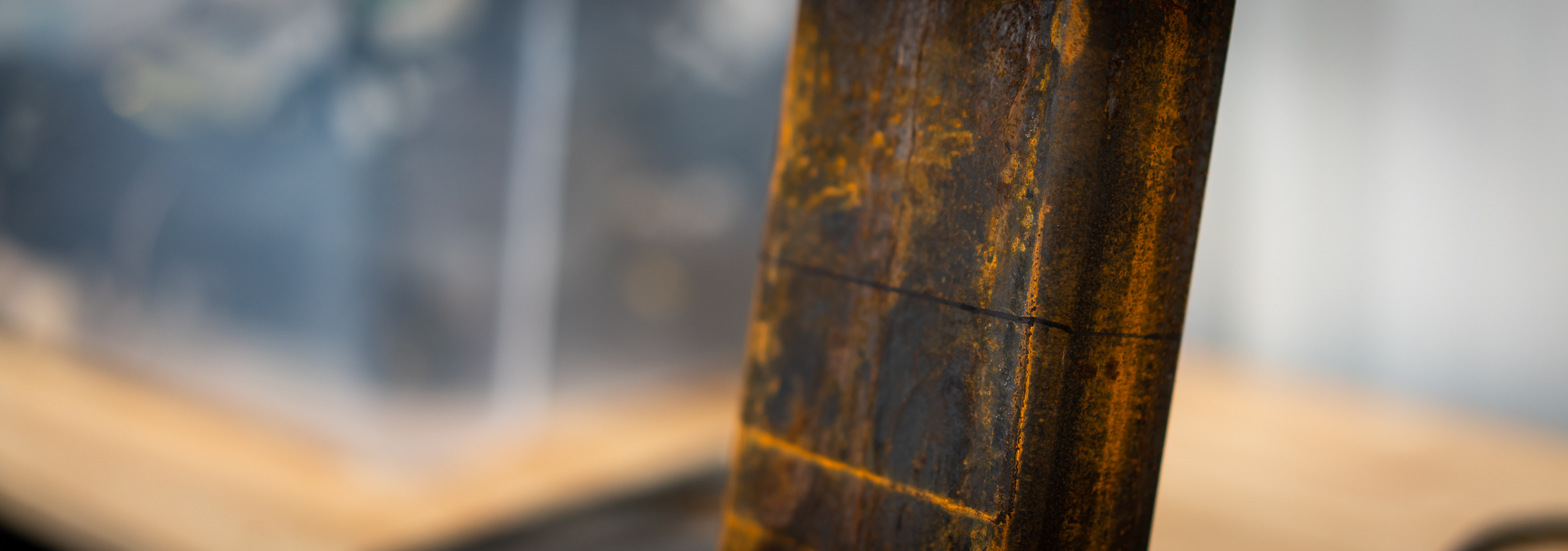Because the engine test stand I bought is meant for domestic V8's, it won't bolt up to the incomplete Nissan mounts on my motor (surprise!), so some sort of mount adapter is needed.
I searched around town (Houston is a decent town to find raw materials) for the 4" x 2" 3/16" wall rectangular steel tubing I spec'd for my in-no-way-qualified design. I could find plenty of places to sell me 20 feet of it for ~$140, but I needed < 1 ft. for this project. I don't want 20 feet.
My cold calling scored when I talked to TEXAS IRON AND METAL. They had "less-than-prime" surplus material in the size I was looking for and they'd slice me off any size I wanted. I figured it might be a handy size to have as extra around the shop, so I got 4 ft. for $27.
This 4 ft. piece is like 30 lbs, so it's pretty beefy. I originally wanted 1/4" wall, but that wouldn't fit where I needed, so I hoped 3/16" would be enough. After slinging this piece around, I'm glad I didn't get 1/4". Plenty heavy.
They weren't kidding about "surface rust" on their surplus material.
Living outside in Houston is cruel and unusual punishment.
I feel like achieved a milestone for this project: First use of His Royal Highness, Grinder of Angles, Endangerer of Men, First and Last of His Name.
I actually would have preferred to use the horizontal bandsaw, but that thing is buried deep in the bowels of the yet-unattended-to fab space in the shop.
Next I chopped out half of the bottom to fit over the stand side mount. Here's how that all looked, set in place:
The next step was to drill (4) 1/2" holes. I'd asked Nik earlier in the day if there was a drill press in the shop.
"Not really."
??
I learned that he had a very old drill press that he bought off craigslist 5 years ago. It had started up once when he bought it back then, but hadn't been tested or anything since. I really didn't want to hand drill (8) 1/2" diameter holes in 3/16" steel, so I decided to spend a few minutes to clean and lube it up and try to get it to turn.
So I cleaned and lubed and plugged it in and hit the start button.
Success!
It even has an olde tyme speed adjustment lever that somehow changes the diameters of the drive and load pullies. Neat. Anyhow, with that working, I made the first 4 holes in no time.
Test fit #2 is good.
So I flapper-wheeled most of the crust off and painted it. I'd post the painted final photo, but I used some magic rust-inhibiting black rattle can stuff that absorbs some crazy amount of light, so that pic just looked like a hole in a workbench. This is post-flapper, pre-paint:
Then painted and installed with some "spacers":
I'm an inordinately slow worker (as I think we've well-established at this point), so it took a couple hours to get to this point.
And then I did a second one. In youtube time, that takes < 1 second. It took me like 30 minutes, which I was actually pretty happy with. So I bolted the second one up as well, which meant it was time for the move!
There weren't any obvious spots or bolt holes to lift the engine. The internet shows a lot of people pulling the intake manifold and bolting to something down in there. The junkyard used a seat belt around 1 header and a metal bracket on the front.
I found the bracket, which I'd taken off, and put it back on. Nik found a 6400 lb. strap and some carabiners. So we did the move, junkyard-style.
Lift, unbolt the Harbor Freight stand, wheel away, wheel in the new test stand. It worked a treat so I set about finding all the nuts and bolts and washers and bolted everything together. It was a bit fiddly because the stand is so adjustable.
Happily, I was able to find settings on the stand that put the engine in what I consider to be a pretty happy place. Low and centered.
In fact, it's almost even level:
Make the noiiii...... ah, no. Not level by 0.90 deg. Ah well, I'll take it.
Satisfied with the night's work, and despite the fact that it was midnight, I couldn't resist pushing the motor next to the car in the forward/back position I've been brainstorming. That's the position in the above picture, and in this one:
Not a good omen for the firewall.
I took a quick measurement of the transmission on the ground (~32") and added that to the back of the engine to see where a shifter would be with the engine located here. I didn't take a picture, but it wasn't quite as bad as I thought it might be. Maybe 6-8" behind the stock location?
Anyhow, for some reason this felt like a very satisfying accomplishment for the night.
Next is continuing with the wiring harness.
Thanks for reading!
damen
Next Datsun Post: Craft Project Gone Wrong
Previous Datsun Post: Engine Stand
All the Datsun Posts: 600HP V8 Datsun 280Z























